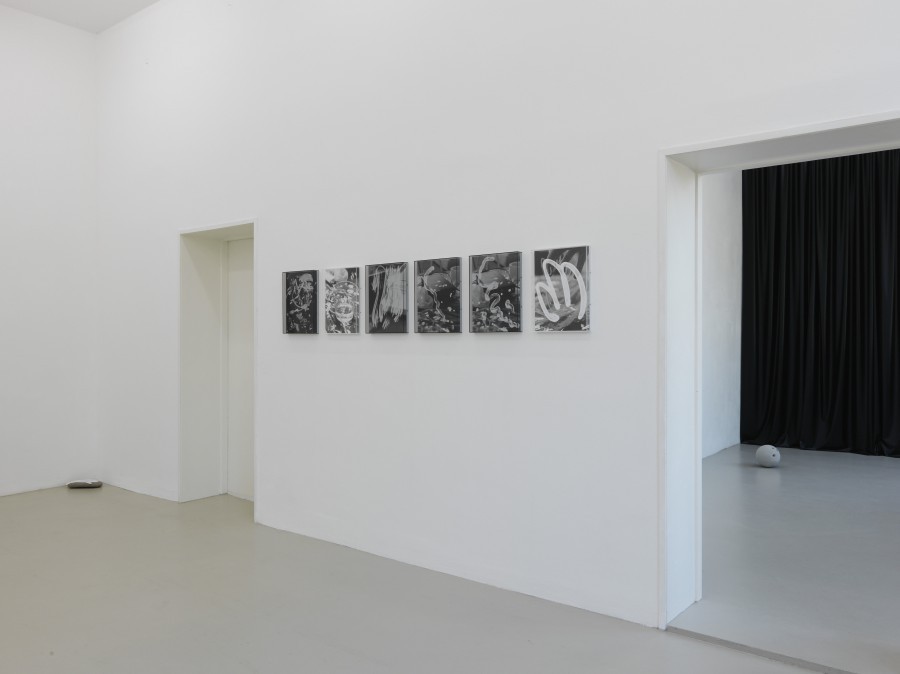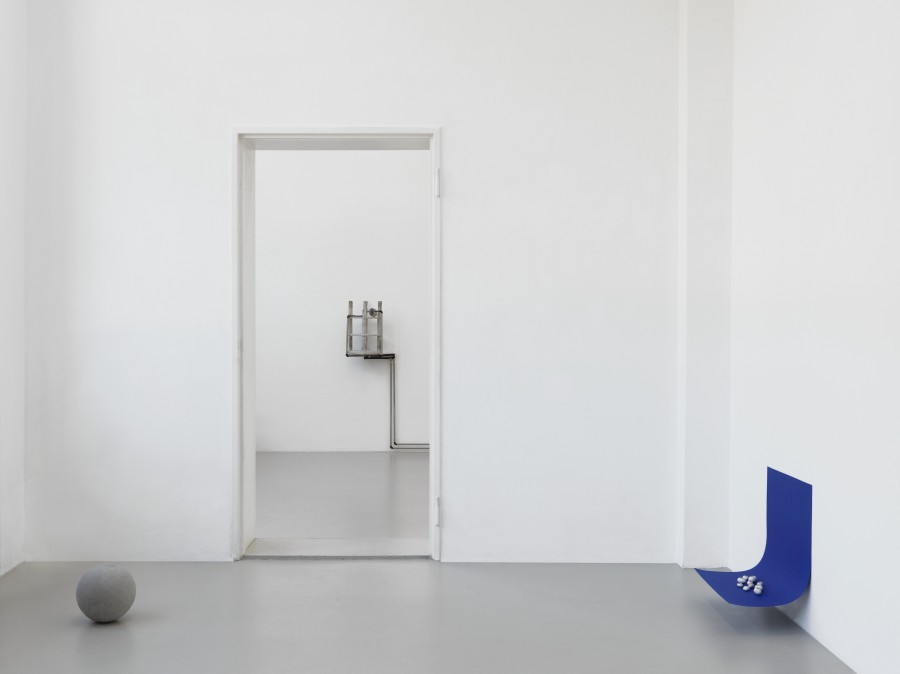Gestures of Tomorrow
10 Sep - 20 Nov 2016
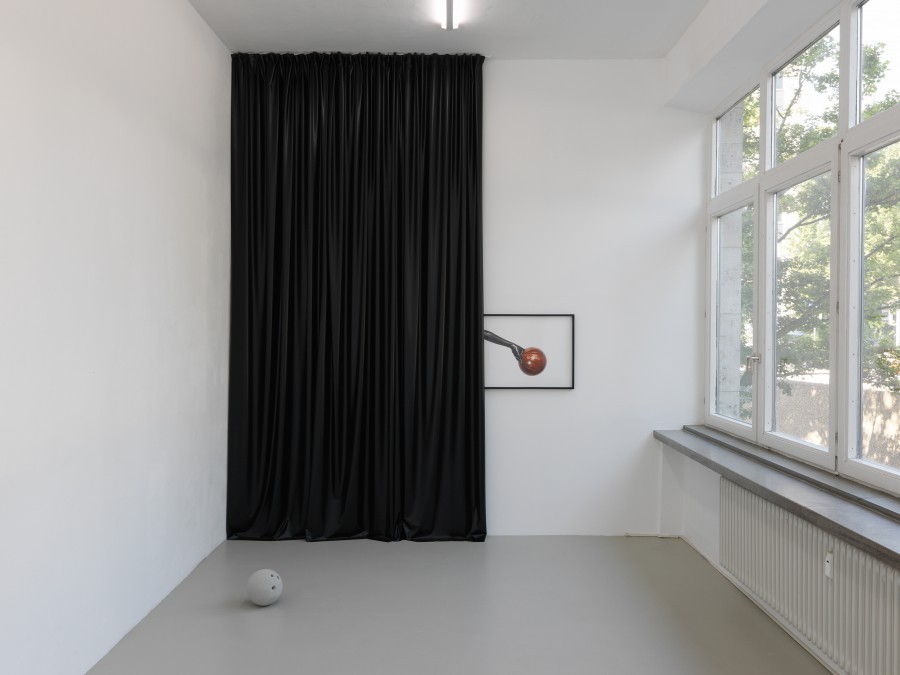
Nona Inescu
Sleight-of-hand, 2015 / Moon Moon Moon, 2015
Installation view, Kunstverein Nürnberg – Albrecht Dürer Gesellschaft, 2016.
Courtesy the artist; SABOT, Cluj-Napoca (RO)
Sleight-of-hand, 2015 / Moon Moon Moon, 2015
Installation view, Kunstverein Nürnberg – Albrecht Dürer Gesellschaft, 2016.
Courtesy the artist; SABOT, Cluj-Napoca (RO)

Nona Inescu
Dactyloscopy, 2015
Installation view, Kunstverein Nürnberg – Albrecht Dürer Gesellschaft, 2016.
Courtesy the artist; SABOT, Cluj-Napoca (RO)
Dactyloscopy, 2015
Installation view, Kunstverein Nürnberg – Albrecht Dürer Gesellschaft, 2016.
Courtesy the artist; SABOT, Cluj-Napoca (RO)
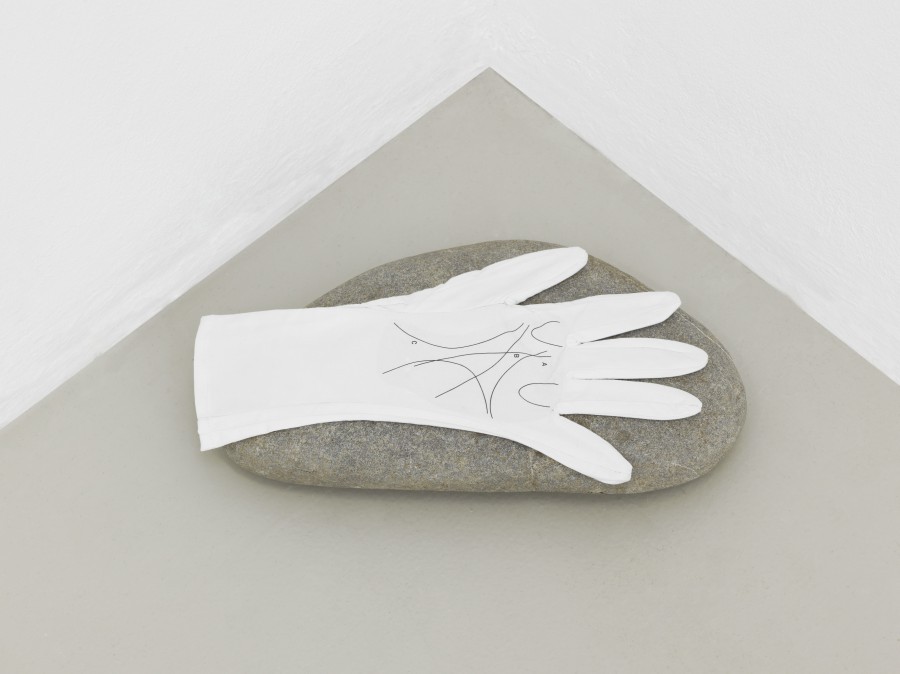
Nona Inescu
Palmistry, 2015
Installation view, Kunstverein Nürnberg – Albrecht Dürer Gesellschaft, 2016.
Courtesy the artist; SABOT, Cluj-Napoca (RO). Photos: Annette Kradisch
Palmistry, 2015
Installation view, Kunstverein Nürnberg – Albrecht Dürer Gesellschaft, 2016.
Courtesy the artist; SABOT, Cluj-Napoca (RO). Photos: Annette Kradisch

Gestures of Tomorrow
Installation view, Kunstverein Nürnberg – Albrecht Dürer Gesellschaft, 2016. Photos: Annette Kradisch
Installation view, Kunstverein Nürnberg – Albrecht Dürer Gesellschaft, 2016. Photos: Annette Kradisch
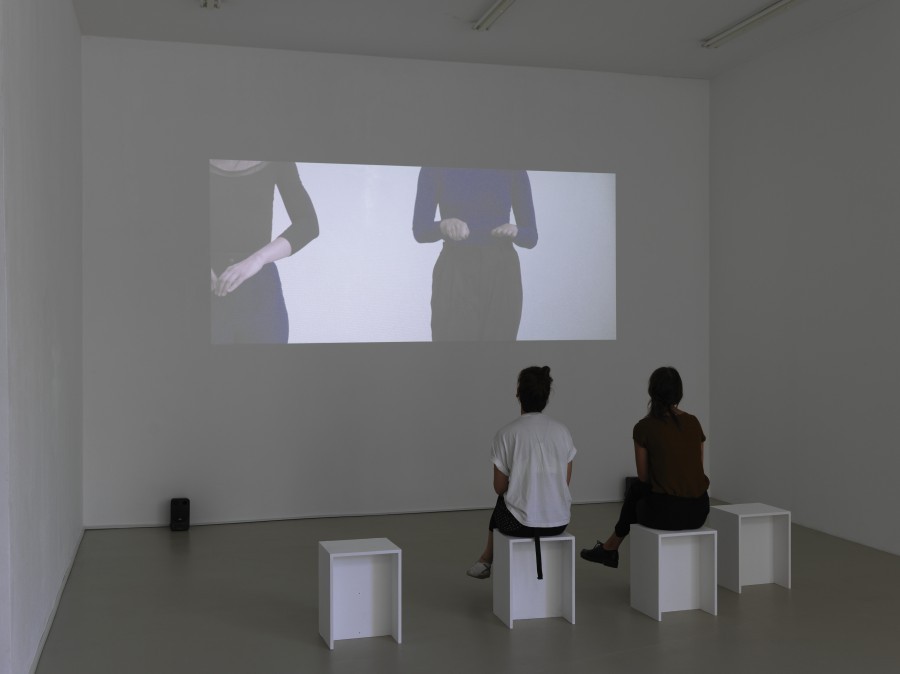
Julien Prévieux
What Shall We Do Next? (Séquence #2), 2014
Installation view, Kunstverein Nürnberg – Albrecht Dürer Gesellschaft, 2016.
Courtesy the artist; Galerie Jousse Entreprise, Paris
What Shall We Do Next? (Séquence #2), 2014
Installation view, Kunstverein Nürnberg – Albrecht Dürer Gesellschaft, 2016.
Courtesy the artist; Galerie Jousse Entreprise, Paris

Julien Prévieux
What Shall We Do Next? (Séquence #2), 2014
HD-Video 16:47 min, Film Still. Courtesy the artist; Galerie Jousse Entreprise, Paris
What Shall We Do Next? (Séquence #2), 2014
HD-Video 16:47 min, Film Still. Courtesy the artist; Galerie Jousse Entreprise, Paris
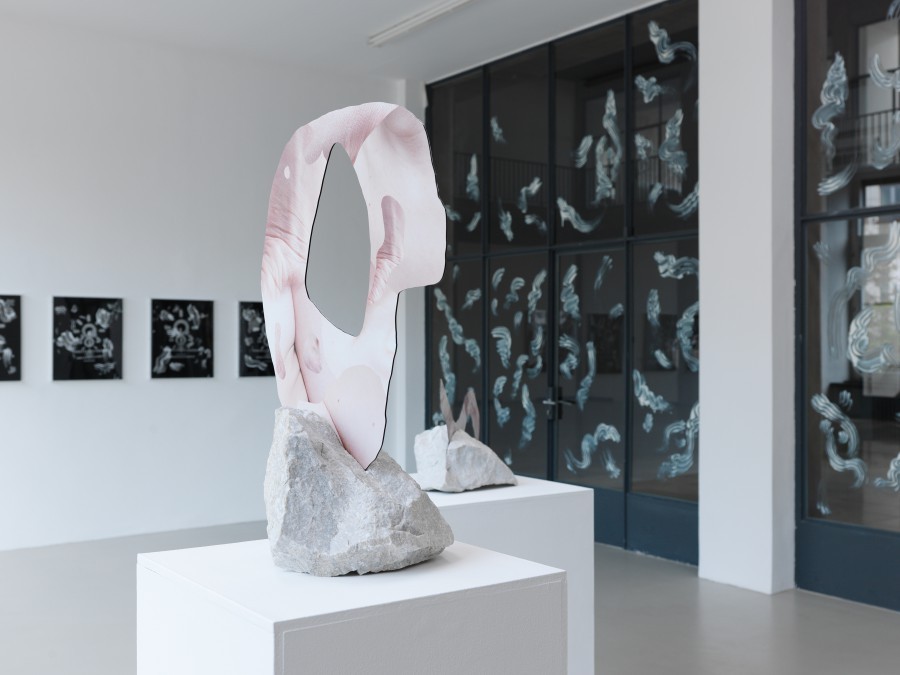
Rachel de Joode
Sculpted Human Skin In Rock III, 2015
Installation view, Kunstverein Nürnberg – Albrecht Dürer Gesellschaft, 2016.
Courtesy the artist; Neumeister Bar-Am, Berlin
Sculpted Human Skin In Rock III, 2015
Installation view, Kunstverein Nürnberg – Albrecht Dürer Gesellschaft, 2016.
Courtesy the artist; Neumeister Bar-Am, Berlin
GESTURES OF TOMORROW
Julien Prévieux, Mia Goyette, Nona Inescu, Rachel de Joode, Sandra Vaka Olsen
10 September - 20 November 2016
The exhibition Gestures of Tomorrow confronts social and technological inscriptions on the human body. Closing in on the interrelationship between everyday activities and digital developments, it examines their impact on our intuitive, gestural vocabulary. How do new technologies affect us and what gestures do they bring about?
In recent decades, our hands have become increasingly important as a means of communication in areas that have since continuously shifted. As machines replace manual labour, the hand’s area of activity has gained new meaning through the automation and standardization of work processes. At the same time, digital media have led to new movement patterns that significantly affect our body and our living environment. For example, the introduction of touch screens has replaced the pressing of buttons and keys with movements such as “swiping”, while the operation of computers will likely be possible with nearly no physical touch at all, thanks to ultra-sensitive radar technology.
The artists approach this theme from a variety of perspectives. While some have conducted scientific research on the future of our movements, others have meticulously explored the physical footprints and traces of human behaviours. A comprehensive study on gestures, for example, includes an analysis of movements arising from the operation of technical devices (Julien Prévieux). The artists also reflect on how the human body might optimize itself, in light of current developments in the area of “human enhancement” and pharmaceutical microbiology (Sandra Vaka Olsen, Rachel de Joode). Given its role in operating a wide variety of devices, the hand is scrutinized in its function as a tool and instrument, but also as a metaphor of the individual and the tactile (Mia Goyette, Nona Inescu). This touches on issues such as the dual function of human gestures between revealing and concealing, and conscious and unconscious action.
The works presented in the exhibition are distinguished by their particular affinity to performative strategies and an eagerness for experimentation during the production process. With their individual observations of reality, the artists engage with the current discourse surrounding the interaction between the human organism, the environment and visionary technologies.
Julien Prévieux (*1974 in Grenoble, FR; lives in Paris)
At Kunstverein Nürnberg, Julien Prévieux presents his film What Shall We Do Next? (Sequence #2), which is based on the eponymous performance that he developed in 2014 during a residency at the Fahrenheit project space in Los Angeles. During this time, Prévieux visited the US headquarters of Apple and Google. He distilled the operating sequences that he studied there into an abstract choreography performed by six performers. Detached from their original context and without their correlating hardware, the gestures are strung together in a rhythmic sequence of actions that reveals parallels to dance. During the choreography, the performers identify the year in which their respective gesture was patented. What Shall We Do Next (Sequence #2) addresses the evolution of technology and its occasionally absurd relationship with the body, and also questions current developments in copyright law.
In his sculptures, performances and video works, Julien Prévieux examines the impact that new technologies have on human social and physical behaviour. For more than ten years, Prévieux has been investigating gestures and movements that stem from our interaction with technical devices. These are often closely related to new device patents that include specific hand gestures for their use. Global technology companies registered movements – such as swiping – as an integral part of their products with the US Patent and Trademark Office, even before the devices were ever available on the market.
Mia Goyette (*1989, Rhinebeck, NY, USA; lives in Berlin)
Mia Goyette deals with the various materialities of our immediate environment in her artworks, with a central focus on structures and fluids that fluctuate between naturalness and artificiality. They bring together concrete and forms cast from epoxy resin with metallic surfaces, dust particles or artificially coloured, algae-infused water. For her sculptures and installations, Goyette frequently looks to everyday objects and consumer goods, which she examines in regard to their relationship with the human body and their functional value in society.
With a series of works specially produced for this exhibition, Goyette comments on human intervention with specific material conditions and existing architectures, by revealing and reassessing them through artistic reformatting and unexpected combinations. She also reflects on the impact of our actions on the environmental resources available to us today. With The prospect of an end (2016, she casts concrete models of the frames of fictitious buildings, reminiscent of unfinished building sites and other modern ruins. Individual hands cast in debris-filled resin and cement – detached from the body and presented in their function as instruments of agency – penetrate these architectural constructions and interact with steel pipes extending onto the wall. Mediating both systems, they seem like prostheses that have assumed various gestures of grasping and holding, in order to either repair the structures or dismantle them altogether.
Nona Inescu (*1991, Bucharest, Romania; lives in Bucharest)
Nona Inescu has focused her recent work on the study of the hand as an instrument of knowledge, as a symbol of the individual and as a haptic organ, through which we come into contact with the world. Using photographs, objects and installations she directs her attention to cultural phenomena surrounding the motif of hands – from dactyloscopy, the biometric process on which fingerprint identification is based, to the practice of palmistry, situated at the border between science and mysticism.
At Kunstverein Nürnberg, Nona Inescu presents a selection of her series Hands don’t make magic, which she developed last year. A central work in this series is a photograph of an arm with a black latex glove that comes into contact with a bowling ball. Its title, Sleight of Hand, points to the gestural tricks performed by magicians. Together with the theatrical curtain that partially conceals the photograph, the work refers to a complex interplay of veiling and unveiling that pervades many of the artist’s works. With Moon Moon Moon (2015), she presents two cast concrete bowling balls that appear haphazardly arranged in the exhibition space, reminiscent of abandoned sports equipment. With reduced gestures and precise arrangements, the viewer becomes integrated into a space that awakens associations with a theatrical situation or training session, and resonates with a multitude of possible narratives.
Rachel de Joode (*1979, Amersfoort, Netherlands; lives in Berlin)
The works by Rachel de Joode are situated in the realm between the physical and virtual worlds. Based on handmade, ephemeral structures, her works are strongly influenced by computer screen-based representation and the digital media’s power of illusion. Through these creations, de Joode explores relationships between three-dimensional objects and their two-dimensional (re)presentation, focusing on the interplay between fictional and factual material structures and surfaces.
For this group exhibition, de Joode presents three works from her series Sculpted Human Skin in Rock (2014-2015), which deals with the nature of human skin. Two-dimensional amorphous forms are printed with photographic close-ups of human body parts, merging into fluid and transformative figures. Here, de Joode approaches the immaterial as a condition that we confront on a daily basis through the Internet, and applies this to the human organism. Formally, the objects oscillate between the physical reality of the body and its flattened, dematerialized opposite on the screen. With her series, Rachel de Joode examines the new ways in which digital experiences are reformulating our environment, what physical changes might be initiated through screenbased media and how we could perceive our bodies in the future. She also touches on the current discourse on cyborgs and avatars, and on the morphological and post-sexual body of the virtual world.
Sandra Vaka Olsen (*1980, Stavanger, Norway; lives between Berlin, Copenhagen and Stavanger)
The ambivalent relationship between the human body and new technological developments is an important impulse in the works of Sandra Vaka Olsen. Using sculptures and photographs, she examines the impact that technological progress and pharmaceutical products have on human perception, the organism and the environment. She often draws on performative strategies to inscribe the body in abstract ways into her works.
For the exhibition at Kunstverein Nürnberg, Vaka Olsen developed new works, which she is presenting together with works from her series Suncreampill (2014). These were created with the help of a tactile method: the artist used sunscreen and her own body to leave marks on photosensitive paper before developing it in the darkroom. The artist’s physical imprints and movement traces bring a haptic quality to the photographs, which depict interactions between iPhones, computer screen surfaces and hands. Just as sunscreen lotion protects the skin against harmful radiation, it also prevents the exposure of the photosensitive paper. The project also points out the importance of light in photography, as well as its indexicality. The photographic image can be seen as a trace of the captured object – an imprint resulting from the reflection of light beams off of an object onto a photosensitive medium. For Vaka Olsen, this impression is an actual physical one, so that the moment of touching becomes the motif.
Julien Prévieux, Mia Goyette, Nona Inescu, Rachel de Joode, Sandra Vaka Olsen
10 September - 20 November 2016
The exhibition Gestures of Tomorrow confronts social and technological inscriptions on the human body. Closing in on the interrelationship between everyday activities and digital developments, it examines their impact on our intuitive, gestural vocabulary. How do new technologies affect us and what gestures do they bring about?
In recent decades, our hands have become increasingly important as a means of communication in areas that have since continuously shifted. As machines replace manual labour, the hand’s area of activity has gained new meaning through the automation and standardization of work processes. At the same time, digital media have led to new movement patterns that significantly affect our body and our living environment. For example, the introduction of touch screens has replaced the pressing of buttons and keys with movements such as “swiping”, while the operation of computers will likely be possible with nearly no physical touch at all, thanks to ultra-sensitive radar technology.
The artists approach this theme from a variety of perspectives. While some have conducted scientific research on the future of our movements, others have meticulously explored the physical footprints and traces of human behaviours. A comprehensive study on gestures, for example, includes an analysis of movements arising from the operation of technical devices (Julien Prévieux). The artists also reflect on how the human body might optimize itself, in light of current developments in the area of “human enhancement” and pharmaceutical microbiology (Sandra Vaka Olsen, Rachel de Joode). Given its role in operating a wide variety of devices, the hand is scrutinized in its function as a tool and instrument, but also as a metaphor of the individual and the tactile (Mia Goyette, Nona Inescu). This touches on issues such as the dual function of human gestures between revealing and concealing, and conscious and unconscious action.
The works presented in the exhibition are distinguished by their particular affinity to performative strategies and an eagerness for experimentation during the production process. With their individual observations of reality, the artists engage with the current discourse surrounding the interaction between the human organism, the environment and visionary technologies.
Julien Prévieux (*1974 in Grenoble, FR; lives in Paris)
At Kunstverein Nürnberg, Julien Prévieux presents his film What Shall We Do Next? (Sequence #2), which is based on the eponymous performance that he developed in 2014 during a residency at the Fahrenheit project space in Los Angeles. During this time, Prévieux visited the US headquarters of Apple and Google. He distilled the operating sequences that he studied there into an abstract choreography performed by six performers. Detached from their original context and without their correlating hardware, the gestures are strung together in a rhythmic sequence of actions that reveals parallels to dance. During the choreography, the performers identify the year in which their respective gesture was patented. What Shall We Do Next (Sequence #2) addresses the evolution of technology and its occasionally absurd relationship with the body, and also questions current developments in copyright law.
In his sculptures, performances and video works, Julien Prévieux examines the impact that new technologies have on human social and physical behaviour. For more than ten years, Prévieux has been investigating gestures and movements that stem from our interaction with technical devices. These are often closely related to new device patents that include specific hand gestures for their use. Global technology companies registered movements – such as swiping – as an integral part of their products with the US Patent and Trademark Office, even before the devices were ever available on the market.
Mia Goyette (*1989, Rhinebeck, NY, USA; lives in Berlin)
Mia Goyette deals with the various materialities of our immediate environment in her artworks, with a central focus on structures and fluids that fluctuate between naturalness and artificiality. They bring together concrete and forms cast from epoxy resin with metallic surfaces, dust particles or artificially coloured, algae-infused water. For her sculptures and installations, Goyette frequently looks to everyday objects and consumer goods, which she examines in regard to their relationship with the human body and their functional value in society.
With a series of works specially produced for this exhibition, Goyette comments on human intervention with specific material conditions and existing architectures, by revealing and reassessing them through artistic reformatting and unexpected combinations. She also reflects on the impact of our actions on the environmental resources available to us today. With The prospect of an end (2016, she casts concrete models of the frames of fictitious buildings, reminiscent of unfinished building sites and other modern ruins. Individual hands cast in debris-filled resin and cement – detached from the body and presented in their function as instruments of agency – penetrate these architectural constructions and interact with steel pipes extending onto the wall. Mediating both systems, they seem like prostheses that have assumed various gestures of grasping and holding, in order to either repair the structures or dismantle them altogether.
Nona Inescu (*1991, Bucharest, Romania; lives in Bucharest)
Nona Inescu has focused her recent work on the study of the hand as an instrument of knowledge, as a symbol of the individual and as a haptic organ, through which we come into contact with the world. Using photographs, objects and installations she directs her attention to cultural phenomena surrounding the motif of hands – from dactyloscopy, the biometric process on which fingerprint identification is based, to the practice of palmistry, situated at the border between science and mysticism.
At Kunstverein Nürnberg, Nona Inescu presents a selection of her series Hands don’t make magic, which she developed last year. A central work in this series is a photograph of an arm with a black latex glove that comes into contact with a bowling ball. Its title, Sleight of Hand, points to the gestural tricks performed by magicians. Together with the theatrical curtain that partially conceals the photograph, the work refers to a complex interplay of veiling and unveiling that pervades many of the artist’s works. With Moon Moon Moon (2015), she presents two cast concrete bowling balls that appear haphazardly arranged in the exhibition space, reminiscent of abandoned sports equipment. With reduced gestures and precise arrangements, the viewer becomes integrated into a space that awakens associations with a theatrical situation or training session, and resonates with a multitude of possible narratives.
Rachel de Joode (*1979, Amersfoort, Netherlands; lives in Berlin)
The works by Rachel de Joode are situated in the realm between the physical and virtual worlds. Based on handmade, ephemeral structures, her works are strongly influenced by computer screen-based representation and the digital media’s power of illusion. Through these creations, de Joode explores relationships between three-dimensional objects and their two-dimensional (re)presentation, focusing on the interplay between fictional and factual material structures and surfaces.
For this group exhibition, de Joode presents three works from her series Sculpted Human Skin in Rock (2014-2015), which deals with the nature of human skin. Two-dimensional amorphous forms are printed with photographic close-ups of human body parts, merging into fluid and transformative figures. Here, de Joode approaches the immaterial as a condition that we confront on a daily basis through the Internet, and applies this to the human organism. Formally, the objects oscillate between the physical reality of the body and its flattened, dematerialized opposite on the screen. With her series, Rachel de Joode examines the new ways in which digital experiences are reformulating our environment, what physical changes might be initiated through screenbased media and how we could perceive our bodies in the future. She also touches on the current discourse on cyborgs and avatars, and on the morphological and post-sexual body of the virtual world.
Sandra Vaka Olsen (*1980, Stavanger, Norway; lives between Berlin, Copenhagen and Stavanger)
The ambivalent relationship between the human body and new technological developments is an important impulse in the works of Sandra Vaka Olsen. Using sculptures and photographs, she examines the impact that technological progress and pharmaceutical products have on human perception, the organism and the environment. She often draws on performative strategies to inscribe the body in abstract ways into her works.
For the exhibition at Kunstverein Nürnberg, Vaka Olsen developed new works, which she is presenting together with works from her series Suncreampill (2014). These were created with the help of a tactile method: the artist used sunscreen and her own body to leave marks on photosensitive paper before developing it in the darkroom. The artist’s physical imprints and movement traces bring a haptic quality to the photographs, which depict interactions between iPhones, computer screen surfaces and hands. Just as sunscreen lotion protects the skin against harmful radiation, it also prevents the exposure of the photosensitive paper. The project also points out the importance of light in photography, as well as its indexicality. The photographic image can be seen as a trace of the captured object – an imprint resulting from the reflection of light beams off of an object onto a photosensitive medium. For Vaka Olsen, this impression is an actual physical one, so that the moment of touching becomes the motif.

